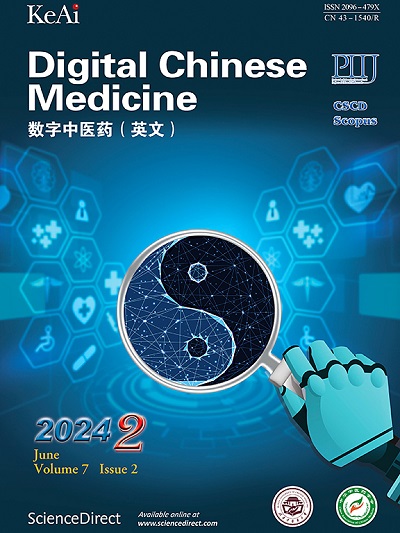基于生物信息学的糖尿病肾病自噬相关基因分析及中药潜力预测
Q3 Medicine
引用次数: 0
摘要
目的通过生物信息学分析预测糖尿病肾病(DKD)自噬相关发病机制和关键诊断基因,并鉴定相关中药。方法采用基因表达图谱(Gene Expression Omnibus, GEO)中测序芯片GSE30528、GSE30529和GSE1009的数据。调节P <的差异表达基因(DEGs);从GSE30528和GSE30529中鉴定出0.05。将这些基因与人类自噬基因数据库相结合,对获得的DKD自噬相关基因进行基因本体(GO)、京都基因与基因组百科全书(KEGG)富集分析和蛋白-蛋白相互作用(PPI)网络分析。随后,采用最小绝对收缩和选择算子(LASSO)回归和支持向量机递归特征消除(SVM-RFE)算法选择自噬相关基因。通过芯片GSE1009的外部验证集分析评估这些基因的诊断能力,并使用SymMap数据库反向预测相关中药。2014</style -content>;从GSE30528和GSE30529中选择deg,鉴定出37个DKD自噬相关基因。氧化石墨烯分析显示了681种生物机制,包括自噬调节和质膜微域活性。KEGG富集分析鉴定出112条相关信号通路。PPI网络分析显示,自噬相关基因在DKD中显著富集。通过LASSO回归和SVM-RFE,我们确定了4个DKD自噬的核心诊断基因:蛋白磷酸酶1调节亚基15A (PPP1R15A)、缺氧诱导因子1α亚基(HIF1α)、肝癌中缺失的1 (dclc1)和ceroid lipofuscinosis neuronal 3 (CLN3)。外部验证集对这些基因具有较高的诊断效率。最后利用SymMap数据库预测出146种潜在中药,其中清热解毒药和活血化瘀药所占比例最大(分别为25/146和13/146)。结论本研究通过对生物信息学测序数据库的分析和验证,阐明DKD自噬的潜在分子机制,预测关键诊断基因、潜在治疗靶点及相关中药,为临床研究和应用奠定坚实基础。本文章由计算机程序翻译,如有差异,请以英文原文为准。
Bioinformatics-based analysis of autophagy-related genes and prediction of potential Chinese medicines in diabetic kidney disease
Objective
To predict the autophagy-related pathogenesis and key diagnostic genes of diabetic kidney disease (DKD) through bioinformatics analysis, and to identify related Chinese medicines.
Methods
Data from sequencing microarrays GSE30528, GSE30529, and GSE1009 in the Gene Expression Omnibus (GEO) were employed. Differentially expressed genes (DEGs) with adjusted P < 0.05 from GSE30528 and GSE30529 were identified. Combining these DEGs with the human autophagy gene database, Gene Ontology (GO), Kyoto Encyclopedia of Genes and Genomes (KEGG) enrichment analyses, and protein-protein interaction (PPI) network analysis were conducted on the obtained DKD autophagy-related genes. Subsequently, the least absolute shrinkage and selection operator (LASSO) regression and support vector machine-recursive feature elimination (SVM-RFE) algorithms were adopted to select autophagy-related genes. The diagnostic capability of these genes was assessed through analysis with the external validation set from microarray GSE1009, and relevant Chinese medicines were inversely predicted using the SymMap database.
Results
A total of <styled-content style-type="number">2014</styled-content> DEGs were selected from GSE30528 and GSE30529, leading to the identification of 37 DKD autophagy-related genes. GO analysis indicated 681 biological mechanisms, including autophagy regulation and plasma membrane microdomain activity. KEGG enrichment analysis identified 112 related signaling pathways. PPI network analysis showed a marked enrichment of autophagy-related genes in DKD. Through LASSO regression and SVM-RFE, four core diagnostic genes for autophagy in DKD were identified: protein phosphatase 1 regulatory subunit 15A (PPP1R15A), hypoxia inducible factor 1 alpha subunit (HIF1α), deleted in liver cancer 1 (DLC1), and ceroid lipofuscinosis neuronal 3 (CLN3). The external validation set demonstrated high diagnostic efficiency for these genes. Finally, 146 kinds of potential Chinese medicines were predicted using the SymMap database, with heat-clearing and detoxifying medicine and blood-activating and stasis-eliminating medicine accounting for the largest proportion (25/146 and 13/146, respectively).
Conclusion
This study analyzed and validated bioinformatics sequencing databases to elucidate the potential molecular mechanisms of DKD autophagy and predicted key diagnostic genes, potential therapeutic targets, and related Chinese medicines, laying a solid foundation for clinical research and application.
求助全文
通过发布文献求助,成功后即可免费获取论文全文。
去求助
来源期刊

Digital Chinese Medicine
Medicine-Complementary and Alternative Medicine
CiteScore
1.80
自引率
0.00%
发文量
126
审稿时长
63 days
期刊介绍:
 求助内容:
求助内容: 应助结果提醒方式:
应助结果提醒方式:


